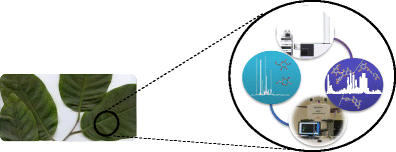Analytical and Bioanalytical Chemistry ( IF 3.8 ) Pub Date : 2018-04-09 , DOI: 10.1007/s00216-018-1051-5 Elixabet Díaz-de-Cerio , Luis Manuel Aguilera-Saez , Ana María Gómez-Caravaca , Vito Verardo , Alberto Fernández-Gutiérrez , Ignacio Fernández , David Arráez-Román
Annona cherimola Mill. (cherimoya) has widely been used as food crop. The leaves of this tree possess several health benefits, which are, in general, attributed mainly to its bioactive composition. However, literature concerning a comprehensive characterization based on a combined approach, which consists of nuclear magnetic resonance (NMR) and high-performance liquid chromatography coupled with time-of-flight mass spectrometry (HPLC-TOF-MS), from these leaves is scarce. Thus, the aim of this work was to study the polar profile of full extracts of cherimoya leaves by using these tools. Thus, a total of 77 compounds have been characterized, 12 of which were identified by both techniques. Briefly, 23 compounds were classified as amino acids, organic acids, carbohydrates, cholines, phenolic acid derivatives, and flavonoids by NMR, while 66 metabolites were divided into sugars, amino acids, phenolic acids and derivatives, flavonoids, phenylpropanoids, and other polar compounds by HPLC-TOF-MS. It is worth mentioning that different solvent mixtures were tested and the total phenolic content in the extracts quantified (TPC via HPLC-TOF-MS). The tendency observed was EtOH/water 80/20 (v/v) (17.0 ± 0.2 mg TPC/g leaf dry weight (d.w.)) ≥ acetone/water 70/30 (v/v) (16.1 ± 0.7 mg TPC/g leaf d.w.) > EtOH/water 70/30 (v/v) (14.0 ± 0.3 mg TPC/g leaf d.w.) > acetone/water 80/20 (v/v) (13.5 ± 0.4 mg TPC/g leaf d.w.). Importantly, flavonoids derivatives were between 63 and 76% of the TPC in those extracts. Major compounds were sucrose, glucose (α and β), and proline, and chlorogenic acid and rutin for NMR and HPLC-TOF-MS, respectively.

The combined use of LC-HRMS and NMR is a potential synergic combination for a comprehensive metabolite composition of cherimoya leaves
中文翻译:

的生物活性化合物的表征
Annona cherimola磨。(cherimoya)已被广泛用作粮食作物。该树的叶子具有多种健康益处,通常主要归因于其生物活性成分。然而,有关这些叶片中基于核磁共振(NMR)和高效液相色谱法与飞行时间质谱法(HPLC-TOF-MS)结合的综合表征的全面表征的文献很少。因此,这项工作的目的是通过使用这些工具研究毛叶番荔枝全提取物的极性分布。因此,已鉴定出总共77种化合物,其中两种技术均鉴定出12种。简而言之,通过NMR将23种化合物分为氨基酸,有机酸,碳水化合物,胆碱,酚酸衍生物和类黄酮,HPLC-TOF-MS将66种代谢物分为糖,氨基酸,酚酸及其衍生物,类黄酮,苯丙烷类和其他极性化合物。值得一提的是,测试了不同的溶剂混合物,并对提取物中的总酚含量进行了定量(通过HPLC-TOF-MS进行的TPC)。观察到的趋势是EtOH /水80/20(v / v)(17.0±0.2 mg TPC / g叶片干重(dw))≥丙酮/水70/30(v / v)(16.1±0.7 mg TPC / g叶片dw)> EtOH /水70/30(v / v)(14.0±0.3 mg TPC / g叶片干重)>丙酮/水80/20(v / v)(13.5±0.4 mg TPC / g叶片干重)。重要的是,这些提取物中的类黄酮衍生物占TPC的63%至76%。主要化合物为蔗糖,葡萄糖(α和β)和脯氨酸,以及用于NMR和HPLC-TOF-MS的绿原酸和芦丁。

LC-HRMS和NMR的结合使用是毛叶番荔枝叶综合代谢物组成的潜在协同组合











































 京公网安备 11010802027423号
京公网安备 11010802027423号